Digital transformation of the Ille et Vilaine department - Feedback
Highlights of the Ille et Vilaine local authority's experience during a webinar in partnership with Virage Group , on the theme of digital transformation. Find out all about this ambitious approach, which makes digital technology and related projects the driving force behind a region's transformation. The Conseil Départemental, like more than 20 other departments, uses the PPM tool Project Monitor to manage its IT projects and the projects of its Buildings Department.
Speakers from the Ille et Villaine department:
- Mona IZABELLE - General Delegate for Transformation
- Dominique KERGOSIEN - Digital Transformation Delegate
- Benoît MORAILLON - Digital Systems Manager
Find out more about the highlights of this webinar in this article:
- Digital transformation integrated into the organization of the Ille et Vilaine department
- Why launch a digital transformation plan?
- Building the roadmap: a 15-month project
- Implementation: from roadmap to digital projects
- Best-of Questions/Answers to speakers
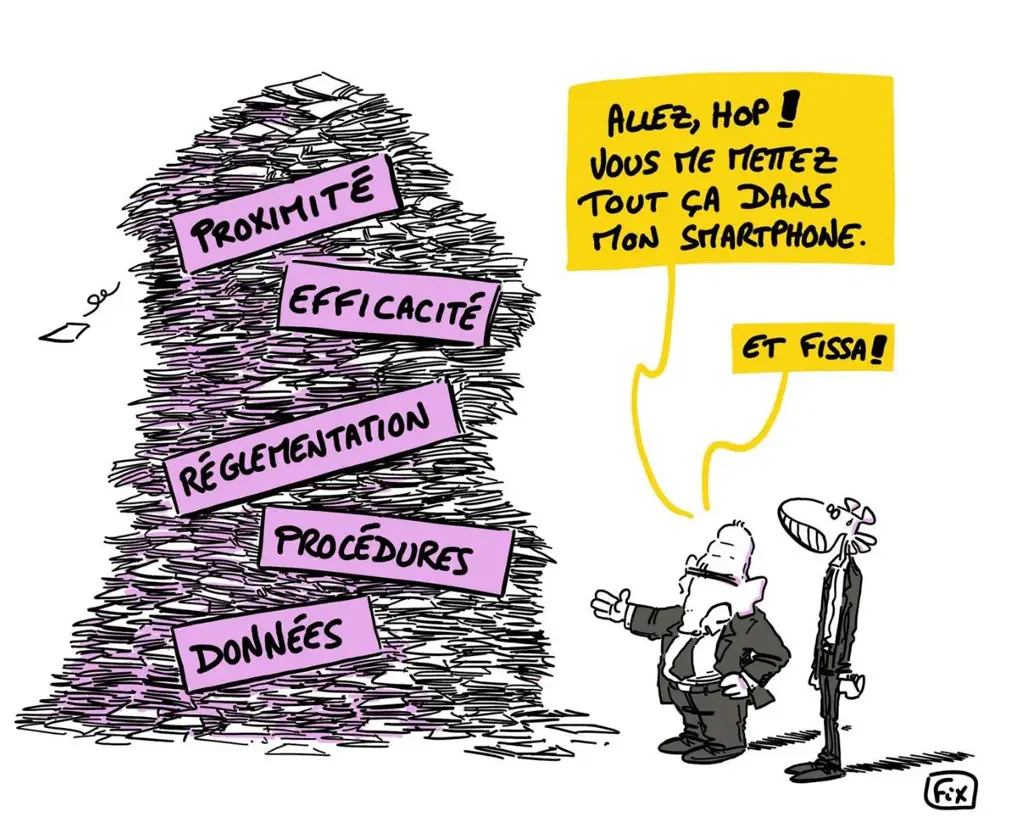
This image of FIX sums up the situation that any CIO, any organization department, any transformation delegation can find itself in when it comes to tackling the digital transformation of a community.
It's solving an apparently insoluble problem:aligning regulatory difficulties, procedural constraints, the need to take data into account, and local efficiency constraints, all thanks to digital tools.
#1 Digital transformation integrated into the organization of the Ille et Vilaine department
The Ille et Vilaine department has just over 4,200 employees, 120 departments and 140 different professions.
The département is responsible for the following compulsory tasks: health and social services for the elderly, the disabled, children and families and people in difficulty, secondary schools, roads, culture, rural amenities, fire safety, and protection of the environment and natural heritage.
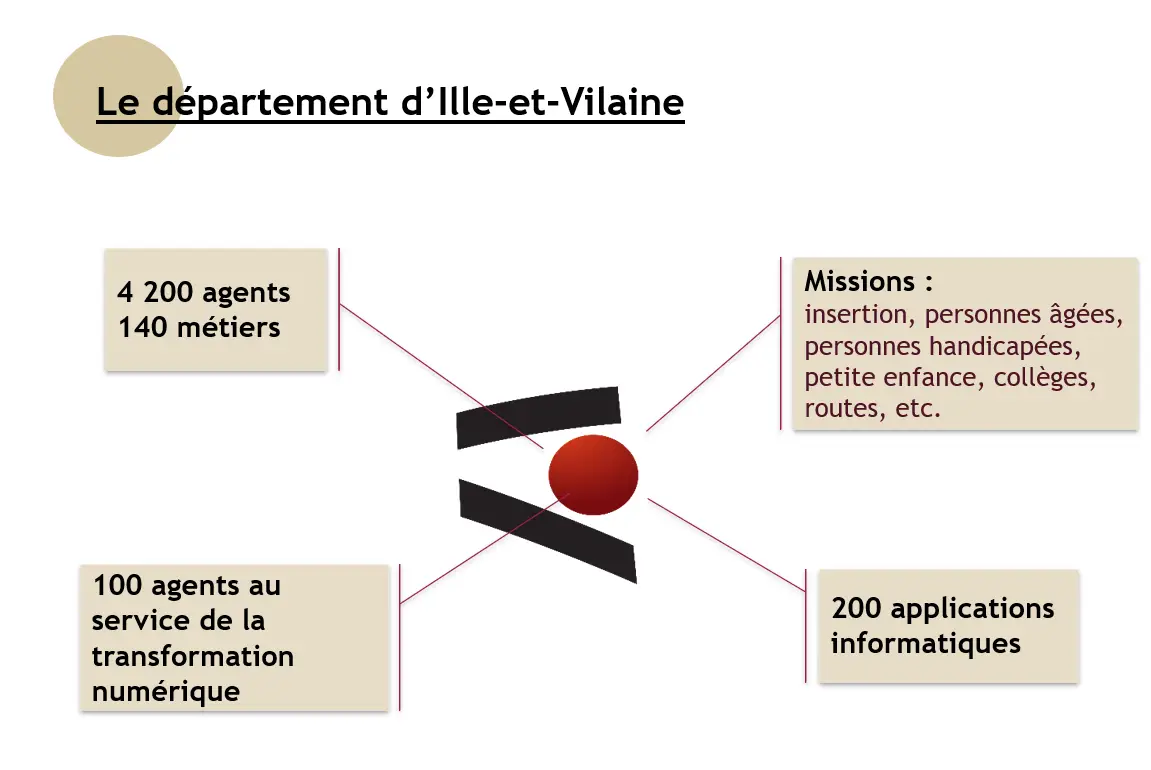
The number of staff involved in transformation in the sense of steering, project management and support represents around 100 people at the Délégation Générale à la Transformation.
They have a fairly rich IS (information system): 200 applications and 3,500 workstations.
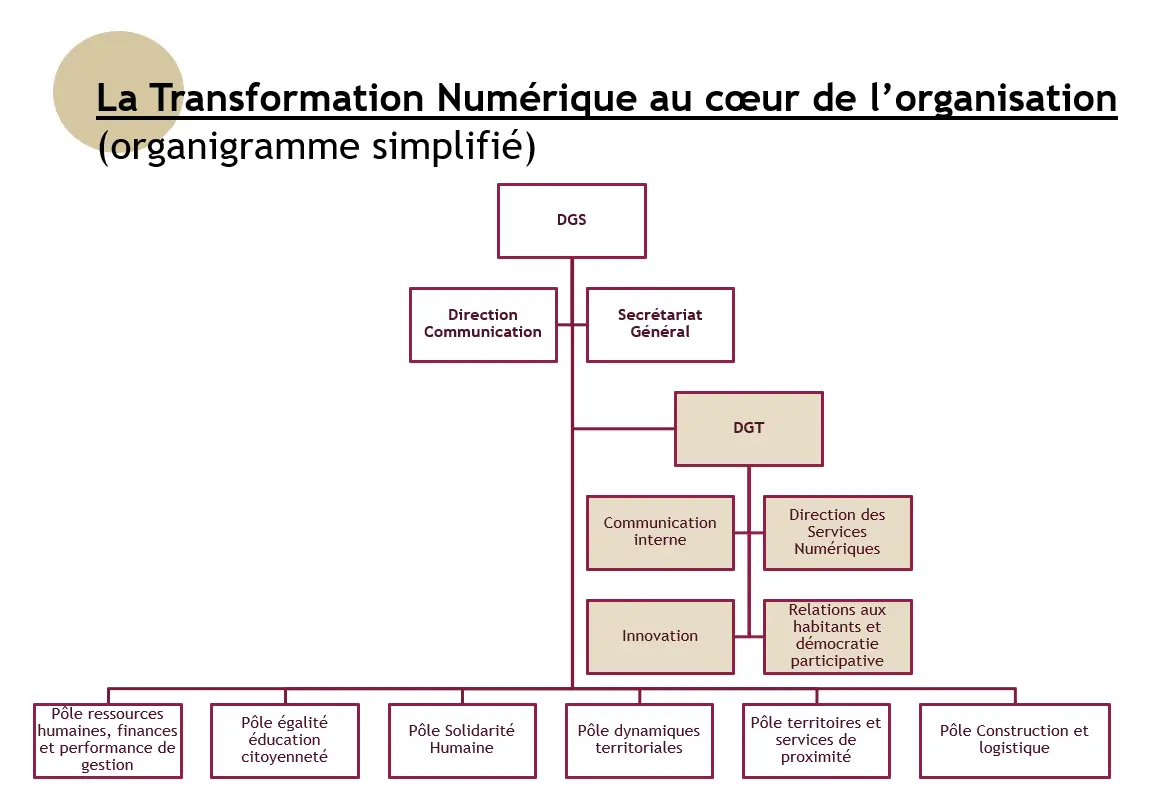
The Ille-et-Vilaine département is organized into areas of expertise.
It operates under a deconcentrated matrix organization, with departmental agencies and departmental social action centers located throughout the département. The General Delegation for Transformation includes the department's internal communications, digital services department, a department for relations with residents and participative democracy, and an innovation department which is the equivalent of a consultancy firm specializing in organization, collective time management and project management assistance for digital projects.
Find out more about the Ille et Vilaine department
#2 Why launch a digital transformation plan?
- This is necessary to meet the expectations of citizens who aspire to simpler administrative procedures.
- The Ille-et-Vilaine department's determination to modernize the local authority and its services to users.
- This is a key challenge, as digital technology is now one of the levers for simplifying and improving efficiency, with limited resources (more than 10,000 inhabitants/year in the department).
- It's also the desire of our elected representatives and general management to choose the type of digital solution we want to implement, because for us, digital technology goes hand in hand with the human dimension, with support for our users and our employees, to ensure that this transformation is a success.
The transformation plan cannot be implemented unless it is supported at the highest level.
Governance must be supported by both elected representatives and senior management. The digital roadmap is the overall framework for all digital issues in the department. The Digital Roadmap Monitoring Committee is made up of the General Manager, the General Secretary, the General Managers of the Sectors and the General Secretaries of the Sectors.
An order from elected representatives and the DGS
At a scoping meeting in September 2018, elected representatives and the General Services Department defined the department's level of ambition: to make digital transformation a facilitator and catalyst for existing operations.
3 objectives:
- Facilitating and simplifying access to rights for users,
- Optimize administrative operations and resources,
- Facilitate agents' work.
"It was an order from our elected representatives and General Management. This approach was taken to the highest level. The department set itself strategic objectives at the start of this work to implement the transformation plan."
#3 Building the roadmap: a 15-month project
The method: co-construction and collective choice
- Choice of AMOA (Assistance à Maîtrise d'Ouvrage) support
- Choosing to work at business department level
- Identification with each of the 17 business divisions of the priority processes that could be improved/transformed by digital technology.
"The idea is to encourage co-construction and not to arrive with a hood full of pre-focused projects, but rather to work with each of the 17 business departments within the local authority. Within each department, we conducted interviews to identify the business processes they felt were the most important and likely to be improved through digital leverage".
This diagram shows the process:
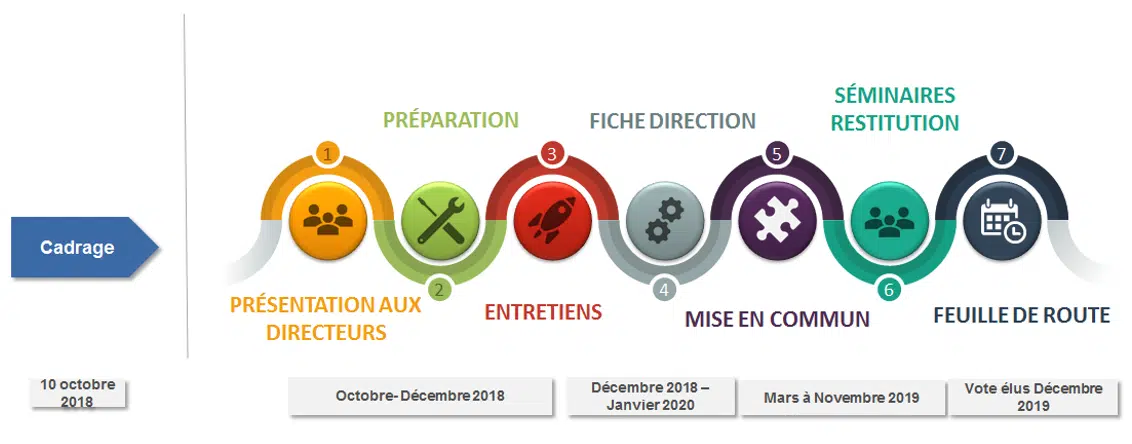
"The project took around 15 months to complete . An initial framing phase with the elected representatives, who set us clear objectives. We conducted ½-day interviews in all departments. Several stages: modeling the identified processes, analyzing and qualifying them (identifying the number of internal or external users). We then shared the results with the business units to check that what had been worked out reflected reality. The most time-consuming phases are stages 5 and 6: pooling, appropriation and acculturation of the departments, as well as of the entire general management, through seminars to jointly prioritize projects and build scenarios".
Process approach: focus on management involvement
- What is a process?
Take a macro snapshot of the sequence of major stages and players involved in achieving the objective. The idea is to work on value chains that cut across the organization, rather than trying to meet specific needs in "silos", which would have led us into technical and organizationally complicated debt schemes.
- Work done during key interviews with the manager
1- Description of key processes with the manager
2- Identify:
- the main stages
- the timescales between stages and for completing each stage, in order to identify the stage(s) on which to focus the optimization work
- the gains (time, resources, value, reliability) via a macro-analysis
"All the processes described, weighted and analyzed were classified, structured into strategic axes that prefigured the axes of the digital roadmap. This progressive construction was then shared with the General Management team through 4 seminars.
Each General Manager spent 4 half-days on the shared culture around challenges digital and digital transformation and then above all what came up from the findings made in their management team. This led to the identification of 60 projects to be carried out or in progress.
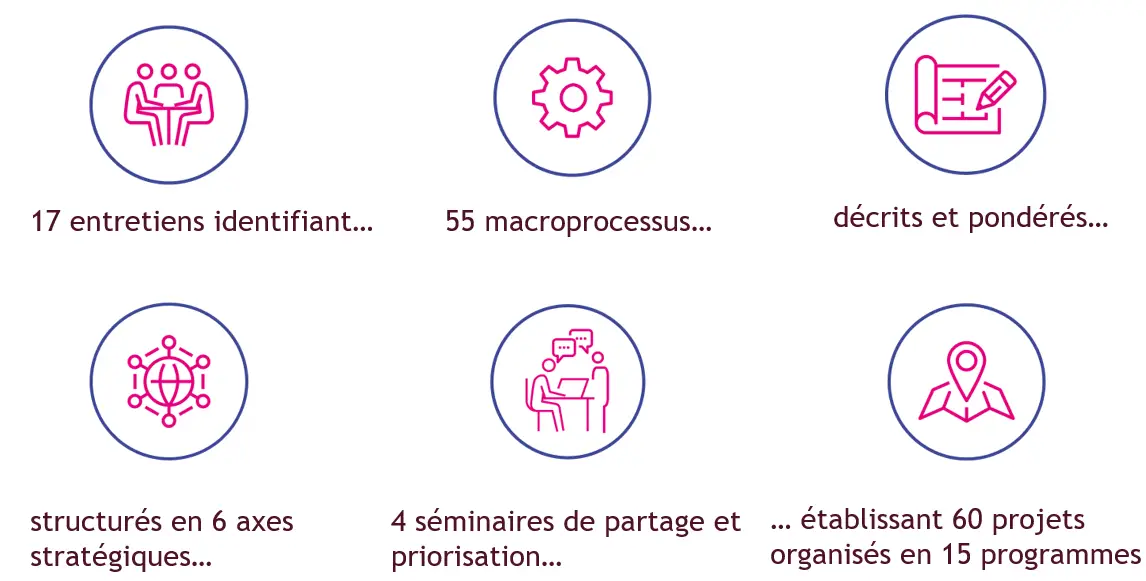
6 strategic axes to structure the Roadmap
To address the two main beneficiaries: local users and local authority employees, the approach was structured around 6 axes.
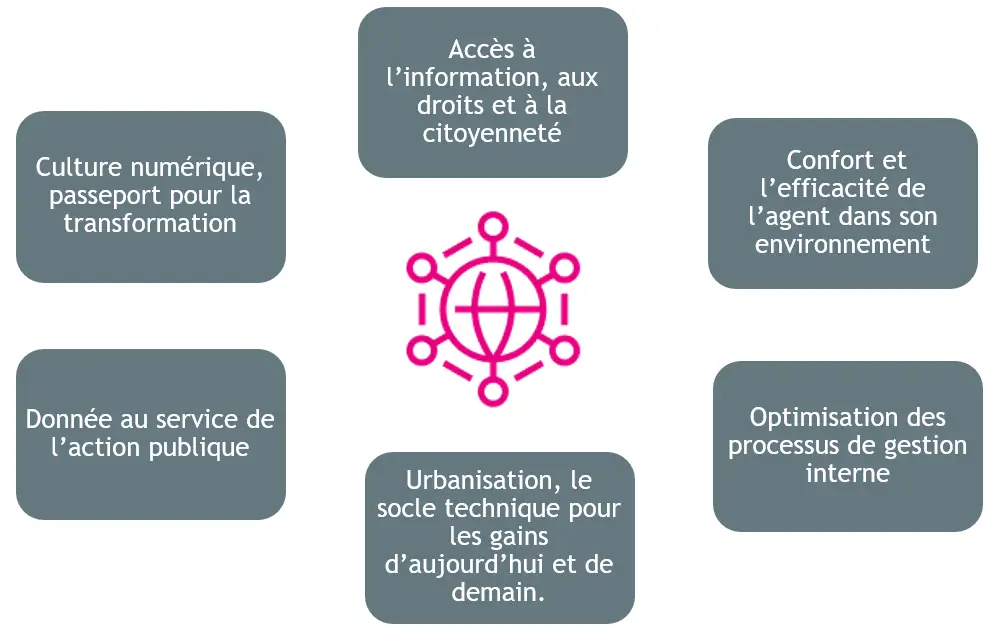
"There is an important strategic axis, which concerns users. The roadmap calls for us to set up a user portal and offer a single portal for all tele-procedures and user procedures. Next, we have created a link with business applications to ensure end-to-end dematerialization.
The 2nd strategic axis concerns agents and internal processes, by setting up an agent portal as a single point of entry. Whether it's for internal procedures, agent files, HR or all aspects of intranet, communication, internal, and also collaborative work with other agents and departments.
We also had to work on the process, revisiting and modernizing it. We've done a lot of work to optimize processes, and we couldn't separate the agent portal from the user portal. Our principle is to have an urbanization logic, a technical base that enables us to reuse and mutualize bricks. These are used to implement this digitization at departmental level. It's a very important change for the departments, because in reality all the departments are used to having specific solutions and consider that their problem is unique.
In terms of data, we also had to structure and define our data policy.
Finally, we have a key focus on digital culture. We support agents and users in these new practices".
Cost calculations
"To calculate the costs involved, we used a specific methodology to evaluate the expenses required to achieve the ambitions of the digital roadmap.
What resources were required for the project management, project implementation, project management assistance and project implementation assistance?
We estimated that we needed as much time for the project management as for the project implementation to be able to implement the digital roadmap with peace of mind.
A major effort adopted by the community's elected representatives in January 2020:
- Choice of an ambitious Scenario from among 5 envisaged
- Adopted by elected representatives to cover 77% of planned transformation projects within three years.
- 15 million in investment over three years to significantly outsource project ownership and project management assistance.
- 3 new FTEs over three years to coordinate AMOE and AMOA resources
"We studied several priority scenarios and evaluated the costs.
How much could this cost us? What human resources would be required?
With the coronavirus crisis, we had to update our schedule to make faster and more extensive use of digital technology.
#4 Implementation: from roadmap to digital projects
The roadmap is a framework for moving from ambition to delivery of new digital services. The department has set itself a number of rules to be respected when implementing projects.
Key implementation principles :
- UX design approach: putting the user (user, citizen and agent) at the heart of digital service design.
- move from the logic of an individual tool to address a need to a digital service platform approach
- overall governance of the roadmap at the highest level of responsibility in the community
The means to implement the digital roadmap :
- legal support (transitional contracts, large-scale tenders)
- organization in project mode (with the creation of a project office) and a project portfolio management tool (Project Monitor) interfaced with budget tracking tools
- revised project mode, with a "Minimum Viable Product" approach
"Our main focus is the implementation plan for this digital roadmap. For its application, we're applying the same principles that governed the choice of scenarios. We have chosen Project Monitora project portfolio management tool. This tool is backed up by our budget monitoring tools .

"We worked in small iterations rather than on a large project with long deadlines. We integrated all the components with a cross-functional team.
We use Scrum-type methodologies, which enable us to iterate quickly. The project owner can very quickly put screens and functionalities into concrete form, so as to be able to get started, test live and validate functionality. With a cross-functional, multi-disciplinary team working in sprints of 1 to 4 weeks at a time, we can quickly produce deliverable functionalities.
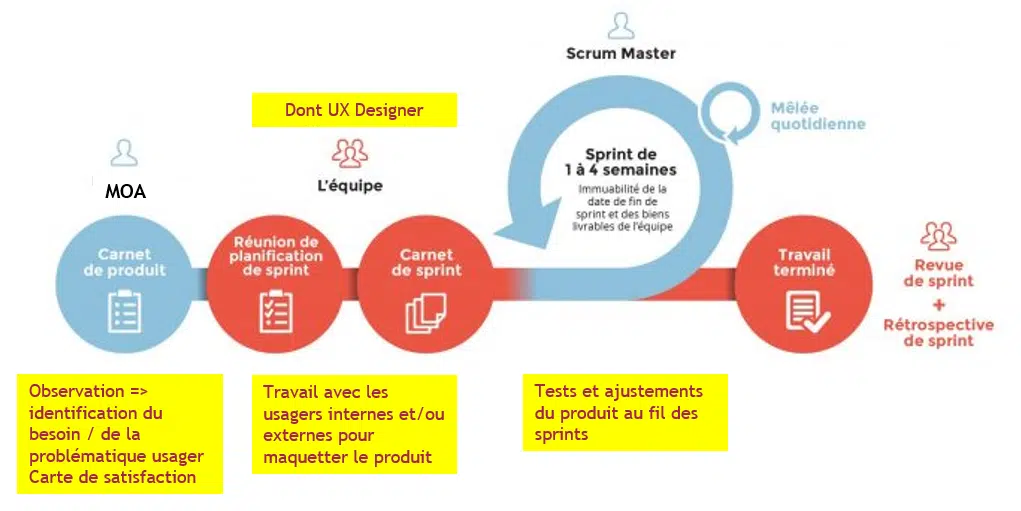
With a platform, we pool the basic technical and functional layers to concentrate on the production of value-added services.
With the platform strategy, the idea is not to respond to specific needs with specific applications, but rather to have cross-functional control of requirements and their instrumentation via large-scale platforms. This enables rapid development and concentrates all technical functionalities in a single back office, which is easier to administer and maintain.
In summary, the 5 key points of the Roadmap
- Ambition on the part of elected representatives and the region, backed by resources
- Involving everyone in the development and choices
- Platform" digital service
- Strategic governance and operational management based on a "Project Portfolio" approach
- Agile project mode as a vector of transformation
"This ambition on the part of elected representatives and senior management requires resources, and cannot simply be a political display. Everyone, at every level, has to get involved, because priorities have to be set. The platform approach enables us to simplify and capitalize on experience and skills. Project management allows us to question ourselves.
Download the Ille et Vilaine case study
Best-of Q&A with webinar speakers
The tele-procedures of the single access portal are not necessarily interfaced with the business applications, this is done progressively: is that right?
" Our strategy is to say that every time we put a procedure online, it's to do an end-to-end dematerialization. This is what we have done, for example, for our Culture and Sport subsidies. In other words, we started with the request and interfaced directly with the business application. Now, it's a very difficult exercise because you have to talk to the editors. What's more, it's not easy to set up these interfaces. We didn't want a multitude of portals, but a single portal for our users. Secondly, given the current situation (COVID-19 health crisis), we may have to start the first stages of certain tele-procedures and defer interfacing with the applications to save time and enable flows to be processed in a dematerialized way "
What costing methodology did you use to size the projects?
"It' s not really a methodology. It was Atexo who supported us and provided calculation standards and dimensioning grids. On certain large projects, 100 man-days of project management corresponded to 100 man-days of project ownership. For project management assistance, we applied a ratio of 0.5 to 0.75 days, per days dedicated to the two previous posts. In other words, we applied an abacus logic to deduce the complete workload .
If part of the work had not been outsourced to AMOA and AMOE, how many Full Time Equivalents was the workload estimated at?
"When we made our calculations, we identified 5 scenarios. A first scenario in which we carried out everything that was requested, in other words, everything that came up in the interviews with the business departments. If we handled everything in-house, we would need 15 additional FTEs at project management level. At business department level, this represented the equivalent of 18 additional FTEs, i.e. at least 1 FTE per department. In a tight budgetary context, this was not possible. By rationalizing as much as possible, we chose a scenario addressing the highest priorities, and opted to outsource the engineering and design department in particular. This brings us to 3 FTEs for project and outsourcing coordination .
Do all the Department's employees have access to a computer? What about the impact of Covid-19 on access to digital environments?
"Yes indeed, we are on a strategy of very strong acceleration on the endowment of equipment for agents. But also, on infrastructures, with the "backbone" that will support digital transformation. We have increased the speed of our Internet gateway by a factor of 10. All of the department's remote sites are now or will be connected to fiber. We are setting up VPNs and collaborative tools. We're accelerating our efforts to provide services that are accessible from anywhere. We want secure, responsive-design, mobile-first Internet services. Our technical platform strategy and UX-design address this objective to guarantee our digital transformation. "
How are the 55 cross-functional macro-processes linked to the various projects?
"The link is not immediate. Sometimes an identified macro-process corresponds to an end-to-end dematerialization project. For example, in the case of the dematerialization of benefit applications for the elderly, we are dealing with a process that has been improved through a complete project, with a tele-procedure component for users and an internal dematerialization component to optimize the process. Sometimes, we have processes addressed by several digital projects. We have 22 departmental social action centers that receive the public on a permanent basis, with different demands. For example, doctors and nurses from the PMI wanted to make appointments for parents coming to have their children examined, and then we have CDAS managers asking for tools to improve the flow of users. The improvement of these processes is provided by a single response with a multi-channel welcome. We use our teleprocedure platform to manage appointment booking, and then set up the necessary organizations in the public reception areas. "
Changes in project methods: do you have targets for reducing the time it takes to make a project available? How can you change team culture?
"Yes, we clearly have objectives to improve the deliverability of our projects. Today, we can no longer produce things in 4 to 6 months, we have to produce them very quickly by the week. For example, we currently have to fill in a form to apply for exceptional subsidies as part of the crisis plan, the support plan implemented by the department. As far as we're concerned, we can't possibly provide this service in a few months' time. By May 11, we need to be able to quickly release the form using our parameterized platform. This doesn't mean that the agents' workload will explode. The idea is to work on strong productivity tools by parameterization. This enables us to deliver quickly, without necessarily needing to set up a complex architecture of servers and databases. The platform strategy should give us the productivity tools we need to deliver these services faster .
Are the solutions you offer developed in-house, or do you use standard software from publishers or open-source software? Can you give us some examples of "platforms"?
"Yes, what we want is to have platforms that give us the whole framework, the whole technical framework that allows us to work fast and produce fast. We want to get away from the classic schema of a specific editor for a specific need. A platform must be open to the outside world, via APIs and web services. It has a functional administration part, a technical administration part, and also embeds all the security components that are indispensable today. Developers will eventually work on these large platforms, for example in the BI and user management fields. We're working with "CapDémat", which is a real roadmap, platform-style, to give us this Swiss Army knife that will enable us to develop a whole host of products. We're going to have products for the major functional segments. For example, on the agent portal, we'll have a major digital Workplace solution. For business intelligence, we have chosen a solution for dashboards and high-performance data visualization. We're avoiding outdated, compartmentalized systems. An editor who is totally closed and hermetic to any open approach or to developments in language x or y which generate technical debt and security holes for us ".
Can you tell us more about the Project Office?
"The Project Office is a new entity that is currently being set up. We are in the process of finalizing its organization. The Project Office is a cross-functional mission of the Transformation Delegation, and will comprise a PMO and a project management assistance coordinator. The idea is to steer project management and resources, but with resource management integrating the project management dimension. This project office approach takes into account the fact that we no longer speak of CIO but of DSN (Direction des Services Numériques), which reports directly to the Transformation Department .
What exactly is planned to bring stakeholders on board for this cultural change? Are there any internal players who are more difficult to get on board?
"As far as the territories are concerned, the department is committed to the implementation of very high-speed broadband. Our transformation plan is focused internally and on our users. What's really important is that we're choosing to modernize the way we deal with users. We are aware that many people find it difficult to deal with online procedures, and that there is exclusion and a digital divide. The département is committed to digital inclusion.
How can we take into account the fact that 15% of people in France have digital difficulties? For the past 1 year, we've been working on the implementation of a digital inclusion approach that aims to take into account existing difficulties according to a classification by the French government and Emmaüs Connect. Around 40% of the French population are experiencing digital difficulties (total exclusion 7% of the population - 15% of the population have a modest use of digital technology and the rest are young people close to digital technology). Our priority audiences are the people we welcome to our social centers. These people benefit from social support. The aim is to help them access their rights online: RSA applications - income tax returns. We have many professionals to help them. We think of support for others in difficulty as a network, meaning that we're starting to work on local partnerships. We're identifying who does what in the area, with - associations - other local authorities - permanent offices in town halls - France Services areas .
Is the RGPD dimension included? and how?"
" On the RGPD, it's a major concern. We've had a DPO (Délégué à la Protection des Données personnelles) since January 1. Right from the start of projects, we need to ask ourselves questions about urbanization, personal data protection and security. "
Has the Ille et Vilaine transformation process been benchmarked with other local authorities? Can this approach be transposed to other departments?
"With regard to the benchmark, we carried out a light survey to find out whether other departments were involved in implementing tele-procedures, and with what types of tele-procedures.
We didn't benchmark the method, because we were supported by the Atexo consultancy. The advantage of our approach is that we can share it and reproduce it elsewhere, both in terms of the method and the process approach. The process approach is difficult, it requires a lot of work, but it's very interesting because it takes departments out of a compartmentalized or tool-based logic ".